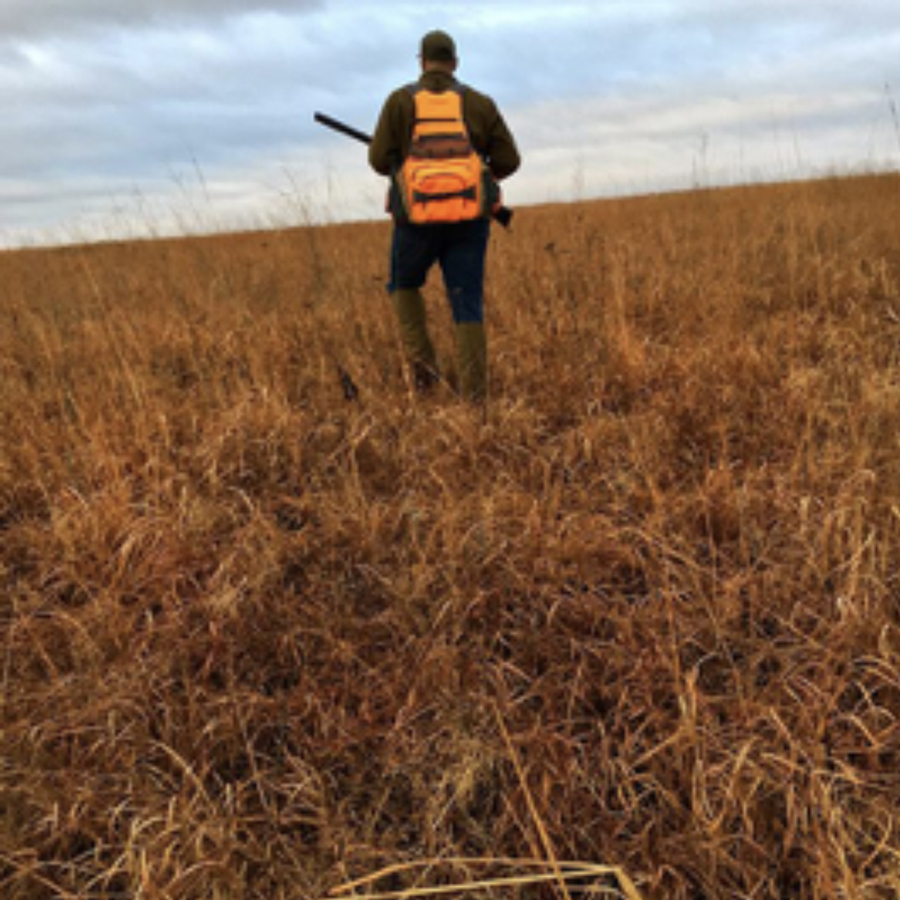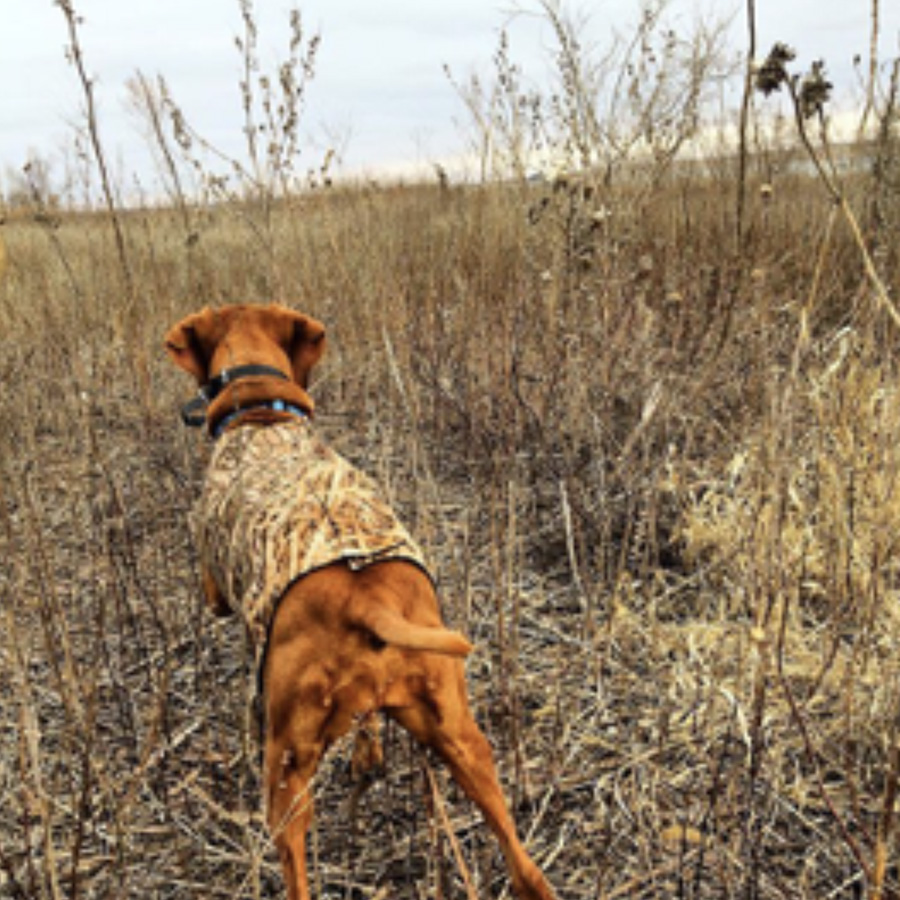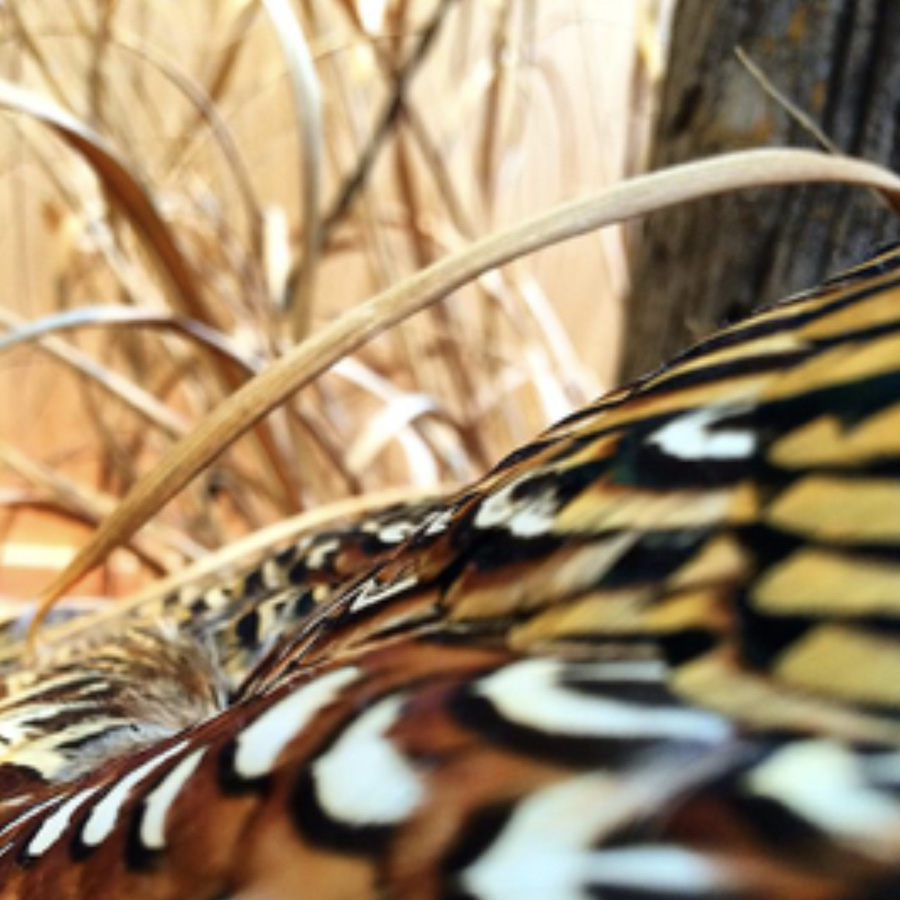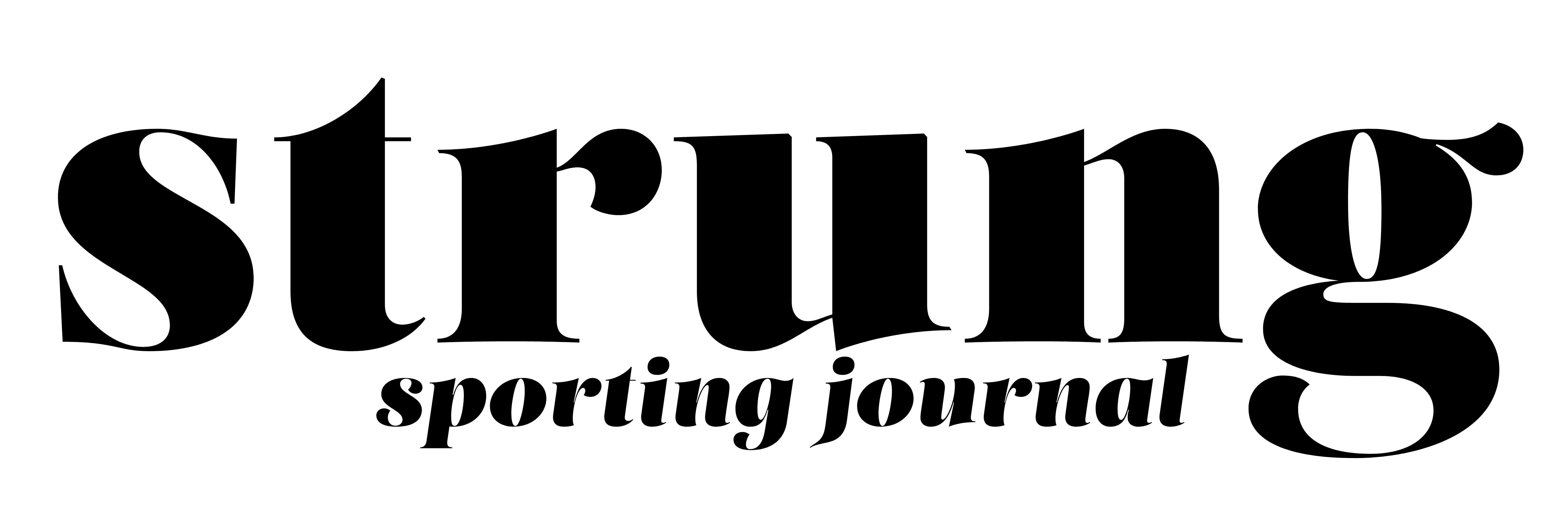by Edgar Castillo
The traveling wingshooter’s vehicle is his or her mobile office, carrying the hunter across the uplands in search of tailfeathers. For those of us who call ourselves DIY public land hunters, our hunting rig is a crucial part of our gear, and whether you own a pickup truck, SUV, car, or something in between, the vehicle must have a great view of the road and a place to gather at the end of the hunt.
As I crest over a hill on a dirt road, a spectacular view of the Kansas landscape lies before me through my windshield. Endless rustic fields bordered by rolling prairies. I am engulfed in a sea of grass on either side. I can see the swaths of grasslands change in the shifting early morning light. Although I’ve slowed the pace of the truck so I can see my surroundings, the speed at which I’m driving still causes motion blur, the apparent streaking of moving objects. In this case, the landscape appears to be suspended in a water-based solution of russet as I peer out from the confines of my truck. I glance over to my cellphone and see the little circle moving toward the marked spot. The brown thumbtack depicts a white pheasant silhouette inside its lines.
The beauty of the uplands derives from the different colors of grass, as autumn and winter conspire to change the landscape, when the remnants of summer’s green vegetation are pretty much gone. I pull the truck over as I catch a glimpse of a square white placard with four bold letters: WHIA (Walk-In Hunting Area), the inviting sign telling me to come and hunt birds. I graciously accept. As the truck drifts off to the side, three anxious roosters flush from the opposite side of the road. The ringnecks had been loafing in the ditch out of the wind. They glide into the very parcel of land where I am about to launch my hunt. Looking out through the windshield, I see three white bands across their necks. A few flaps from their wings, and they drift until settling down about 300 yards in. I look at the rearview mirror to see ripples in the land and dust slowly settling back onto the road. Not a soul around. My gaze returns to the front, and a gray gravel dirt road appears to stretch for miles. Wooden telephone poles with connecting wires stand as lonely and silent sentinels as they stretch to the horizon.
I grab my cellphone and bring up onX. Before my eyes I see a myriad of Tetris-like puzzle pieces connected to form thousands of acres of public-access lands. Many would wonder where to start. Not me. I had seen my feathered fortune cookie fly before me. Actually, three. I press down on the screen and create a waypoint. Eighty acres is the size of the tract, and it lists pheasants and quail as potential species.
Excited to have seen a trio of roosters, I gather myself and step out of my metal gray steed. The earthy fragrance wafts over the whispering prairie. The perfect combination of an autumn chill and the sun’s rays that are piercing through the gray clouds above make for a perfect day afield. I scan across the orange-red-brown colors that resemble the oxidation of iron when it forms rust. The prairie can appear to be bland and monochromatic. Rustic hues are taking over the panoramic scenery. Still and lifeless at first glance. The beauty is subtle. There is life, although hidden until disturbed.
 After throwing on my orange pack-vest and filling the two pouches with crimson shells, I move toward the back of the truck. I put the tailgate down and move to unlock the dog crate. The metal mesh door is unhinged and a dog of the same color as the landscape bounds out and jumps onto the ground. Staley is excited and immediately puts her pink nose to the ground and begins to take in all the smells. I kneel and call her to me. Staley’s docked tail is wiggling like it is battery-operated. I run my butterscotch-colored leather gloves across her back. She takes to the long strokes, and she places her muzzle into my face. It’s cold enough for Staley to exhale a plume of breath. I attach a metal bell to her dog collar. The bell resonates a clear-sounding musical note as the clapper inside strikes the side. Staley knows what is about to happen. Her auburn-colored eyes look past me and into the field.
After throwing on my orange pack-vest and filling the two pouches with crimson shells, I move toward the back of the truck. I put the tailgate down and move to unlock the dog crate. The metal mesh door is unhinged and a dog of the same color as the landscape bounds out and jumps onto the ground. Staley is excited and immediately puts her pink nose to the ground and begins to take in all the smells. I kneel and call her to me. Staley’s docked tail is wiggling like it is battery-operated. I run my butterscotch-colored leather gloves across her back. She takes to the long strokes, and she places her muzzle into my face. It’s cold enough for Staley to exhale a plume of breath. I attach a metal bell to her dog collar. The bell resonates a clear-sounding musical note as the clapper inside strikes the side. Staley knows what is about to happen. Her auburn-colored eyes look past me and into the field.
The moments spent at the tailgate prior to starting each hunt have become ritualistic and memory-filled over the seasons. Staley and I have been hunting together for more than a decade. She has traveled with me to Nebraska and Missouri. A peculiar companionship we have, but not enough time and space to tell that tale now.
I slide my 12 gauge over-and-under from its loden case. I break it open to insert a pair of matching red shot shells. I can still smell the aroma of Sage & Braker’s citrusy cleaning formula from the last time I cleaned it. With a gentle snap, the wood and metal close. I step off. I had marked where the birds had fluttered their wings and landed. I knew from experience that pheasants tend to land with their prehistoric taloned feet ready to run. I would concentrate my approach a bit farther out from where they touched down.
Instantly, the dog and I are both engulfed in the sea of vegetation. I make my way in a zigzagging pattern. Every so often I abruptly stop to see if it causes a premature flush. The Hungarian Vizsla’s coat is the same color as the grass blades. She morphs into the vegetation like she had been painted into it. Only the clanging of her bell signals her whereabouts. I follow the noise.
I move in a half-moon crescent pattern to the location that I have burned into my eyes. Staley is working the field. Quartering back and forth. Ranging a bit farther out than usual. But on occasion she moves closer to “check in.” Staley’s bell is like an unorchestrated melody across the land. My pace quickens when the bell stops its song, only to be teased as I hear a faint clinging and the dog’s movement through the grass. The hunt for roosters continues. This stop-and-go exercise is played out several times. My adversaries in the chess-like game are what I refer to as the court jesters of the uplands, because of their diabolical ways as they attempt to make a fool of hunters.
Then everything is suddenly quiet. I’d last seen Staley about 35 yards out at my ten o’clock position. I only hear the wind’s slight whispering sound. My walk turns into a hasty pace until I spot Staley in some thin grass, her body rigid with her front left leg pulled up to her. I move in just behind her and start angling myself to her right. Staley starts to move in slow motion then abruptly relocates ten yards out. I follow suit and move wide, the grip on my shotgun ever so tighter, anticipating a flush. Staley’s nose is riveted on what appears to be blades of grass. Slowly, I move forward. I scan the ground looking for a place for a pheasant to hide. The habitat had changed about a hundred yards back. The grassy and weedy draw had become sparse.
As if Houston had given the okay for the ringneck pheasant to launch into space, a colorful plump bird erupts into the overcast sky. A series of raucous cackles pierce the air, giving the alarm call to the other two nearby birds to take to the atmosphere. A splash of iridescent rust, red, and white against the dull Kansas sky catches my eyes behind me. I swing around with my over-and-under and shoulder it as the rooster flies away from me. I squeeze the trigger and see the bird take a hit as it tumbles back to the ground. Staley instantly bounds to its location. I see the rooster start running. Oh, no . . . a cripple! The cock bird makes a mad dash but is instantly grabbed around its midsection by Staley, its wings fluttering in the dog’s face.
And just like that the bird goes limp, its long tail dragging, its dark-colored head with its white ring draped downward. I call for Staley, and she abides by prancing over to me. As she reaches me, I kneel down only to be surprised by a series of fluttering wingbeats.
A fourth bird! The long plumes of the cock pheasant ripple in the tailwind like kite tails in the sky. I stand quickly and shoulder my 12-gauge. The barrel tracks the bird as I swing through. Or as the English say, “Butt, belly, beak, bang.” I pull the trigger and an explosion resonates in my body. The rooster folds lifeless in midair. Staley trots over to the second bird and idly waits until I arrive.
 My leather gloves fumble with the top lever of the shotgun and it disengages, allowing the gun to open. Thump, as two shells are expelled from the chambers.
My leather gloves fumble with the top lever of the shotgun and it disengages, allowing the gun to open. Thump, as two shells are expelled from the chambers.
I retrieve both cartridges and insert another pair of shells into the empty dual slots. I take both birds and raise them into the air. No spectators or witnesses. Only Staley and I are there. Their red faces and crisp white collars, along with their tails swaying in the wind, distinguish them from the mottled brown yet still majestic hen pheasant. I place the birds into my game vest. Their weight and their still-warm bodies are a welcome feeling. I turn and motion for Staley and we continue our trek deeper into the field.
We walk and walk, until we come across the western boundary of the enrolled parcel of land giving hunters access onto the private land. We traipse across the land along the fence line as we make our way back to the truck. Four hen pheasants flush on our return.
We peak over a ridge, and I see the gray truck on the dirt road. As I approach, I’m soothed by how I have spent the day. My soul has been replenished. Staley is trotting next to me with her tongue out. She’s still full of energy and wondering, Why are we going back? The smell of birds remains in her nasal passages. She wants to find more. We reach the truck and I set the roosters down onto the tailgate. I lay the shotgun gently down and produce a water bowl. Staley has already plopped down underneath the tailgate. She laps up water. Refreshed. Her head is cocked to one side as she looks whimsically up at me. I’ve hefted both birds into the air, their tails swaying in the wind, feathers moving easily with the breeze. I return the birds to the tailgate and ponder the importance of the metal platform in hunting.
 The purpose of a tailgate is twofold. One is its function. It is a hinged metal flap at the back of a truck that can be lowered for loading and unloading, which for bird hunters usually consists of dogs and gear. It is the place where we get ready for the hunt. The dogs are let out from their long journey in their crates and are released. It is where a hunt begins, where plans and tactics are made and set. The shaking of hands and greetings are done at the tailgate. The tailgate is a place for social gatherings. A place in which an informal meal is served and enjoyed while in the field. A place where dogs can drink water and rest.
The purpose of a tailgate is twofold. One is its function. It is a hinged metal flap at the back of a truck that can be lowered for loading and unloading, which for bird hunters usually consists of dogs and gear. It is the place where we get ready for the hunt. The dogs are let out from their long journey in their crates and are released. It is where a hunt begins, where plans and tactics are made and set. The shaking of hands and greetings are done at the tailgate. The tailgate is a place for social gatherings. A place in which an informal meal is served and enjoyed while in the field. A place where dogs can drink water and rest.
More important, the tailgate is where stories of the hunt are told. Both truths and exaggerations are declared to fellow bird hunters. It’s a place to share memories of past, current, and future hunts. The rewards and moments in the field are captured at the tailgate in the form of photographs.
Finally, it is the place where handshakes are again given to fellow hunters, friends, and strangers. Promises and goodbyes are given until the next outing. I think we tend to overlook the importance of little things, and forget that something as insignificant as a tailgate—or windshield—plays an important part in our lives afield. Before leaving, I take out my cellphone and bring up onX. I press “Edit” and type: Windshields & Tailgates. It’s an appropriate name for this spot.
Read more…


